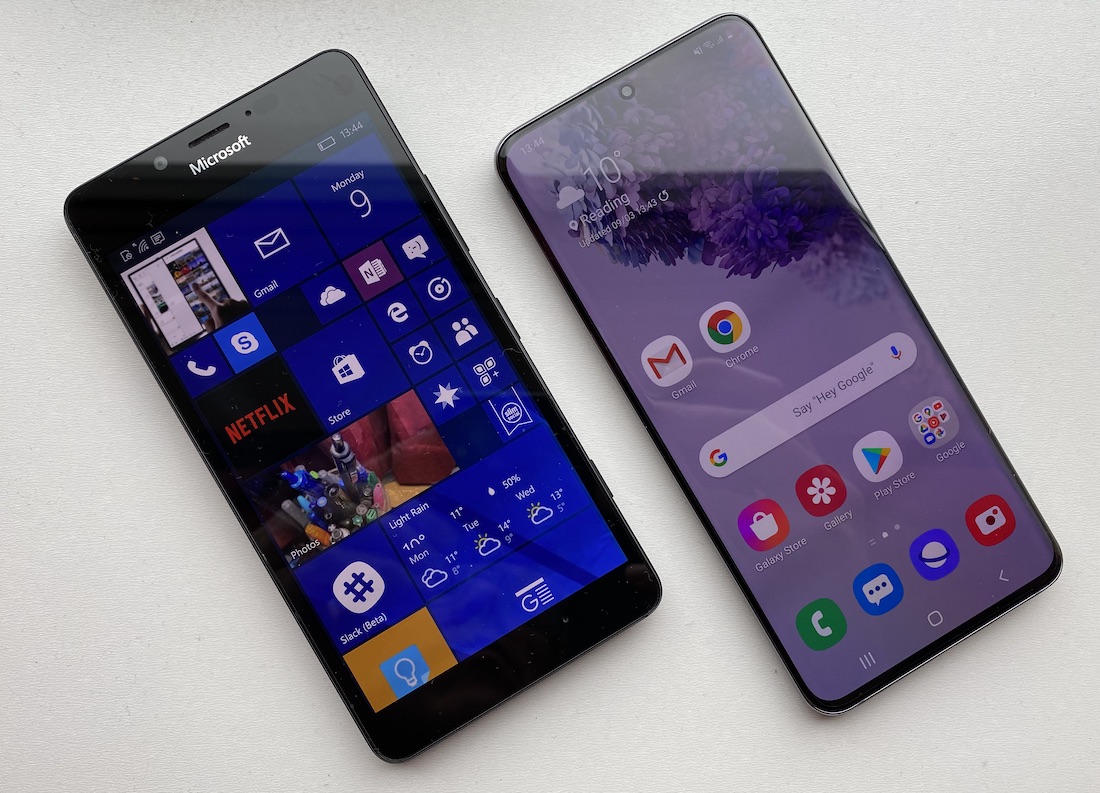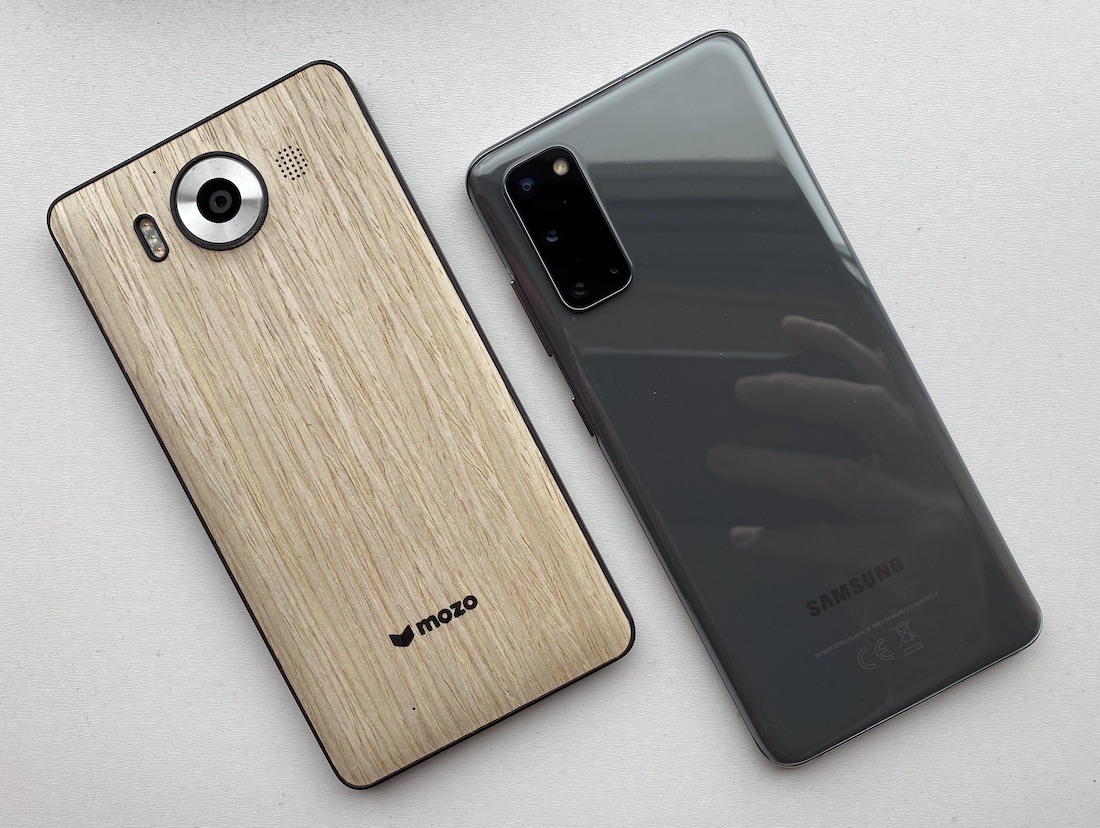
Lumia 950 and Galaxy S20....
Although there's a little life left in Windows 10 Mobile in terms of updates and support, new hardware is non-existent, plus repairs and spares for older hardware are heading the same way - so it makes sense for everyone to be aware of the best of the rest from other platforms. And this new Samsung flagship has top notch imaging, top notch speed, with only a few downsides compared to previous Galaxy generations (removal of a 3.5mm audio jack being one of them).
So, back to the specs - as usual, I've shaded in green an obvious 'win' for either device. Any row where a winner would be totally subjective is left uncoloured. Or, where all devices are utterly excellent but in different ways, I've given each a 'green'(!)
[By the way, if you're viewing this feature on a phone then the table may well cause you problems. Try viewing in landscape mode? Failing that, go view this on a laptop or tablet!]
| Microsoft Lumia 950 | Samsung Galaxy S20 | |
| Date first available | November 2015 | March 2020 |
| Current price, availability | No longer officially for sale, though it's often on clearance prices if you're lucky and at outrageous profiteering prices due to rarity (if you're not!) | From £799 on Samsung's site in the UK. |
| Dimensions, form factor, weight |
145 x 78 x 73mm, plastic chassis and replaceable backs (plastic/leather/wood etc, from Mozo, as modelled here!), 150g, bezels are comparatively small |
152 x 69 x 8mm, 163g, glass front and back, sealed as per modern smartphones, very small bezels |
| Durability | No specific durability metrics, though the fact that the back comes off will help enormously for water damage, i.e. taking out battery and cards immediately, drying out the internals, even unscrewing the motherboard from the guts of the phone. I'm old-school here! All damage to the back or corners is trivial through replacement of the rear, but the screen's exposed, of course. If spare parts were all still available, all this would get a win here, but I notice that the likes of Replacebase have stopped listing replacement Lumia 950 screens, so it's all a little bit moot... |
IP68 water and dust proofing gets the win overall, though the all-glass surface does mean that a case is mandatory. Really. I managed to crack a flagship phone screen only the other day (long story)... |
| Operating system, interface | Windows 10 Mobile, (dismissable) virtual controls, as needed, now officially updated to W10 Fall Creators Update (Redstone 3, Autumn 2017) with security to 'January 2020'. |
Android 10, One UI 2.0, ??? 2020 security, choice of gesture controls
|
| Display |
5.2" AMOLED (1440p at 16:9 aspect ratio, matching most video media), Gorilla Glass 3, ClearBlack Display polarisers help with outdoor contrast, excellent viewing angles. Screen area is approximately 75cm2 Glance screen available (in various colours) for always-on time, day and notification icons, plus some detailed info from a specified app, give the Lumia the win here. |
6.2" 1440p AMOLED, up to 120Hz, 20:9 ratio, Gorilla Glass 6, screen area is roughly 94cm2 Highly customisable Always On Displays and controls. |
| Connectivity |
LTE, NFC (all uses), Wi-Fi b/g/n/ac, integral wifi tethering, Bluetooth 4.2 (all uses). Continuum connectivity to use a wide range of first and third party UWP apps on external displays as secondary screen, independent of the phone display. Includes the new NexDock 2, transforming the Lumia into a Windows 10 S laptop, effectively. |
LTE, NFC (all uses), Wi-Fi b/g/n/ac/ax, integral wifi tethering, Bluetooth 5.0 (all uses). Samsung DeX desktop available via HDMI out over Type C to the NexDock 2 or similar accessories. |
| Processor, performance | Snapdragon 808 chipset, 3GB RAM, decently smooth on the Fall Creators Update though still slower for almost everything than on the Android phone. Multi tasking and app resumption is excellent though, at least with all the modern UWP apps |
Exynos 990, 8GB RAM, very fast at everything compared to the Lumia, things just happen instantly |
| Capacity | 32GB internal storage, expandable via (cheap) microSD to extra 256GB | 128GB internal storage, plus microSD support if you don't need the second nano-SIM slot. |
| Imaging (stills) |
20MP PureView f/1.9 1/2.4" BSI sensor, Phase Detection auto-focus, dedicated camera shutter button and launch key, genuine 2x lossless digital zoom (in 8MP oversampled mode), OIS. 'Rich Capture' produces customisable HDR shots and 'dynamic flash', with triple LED illumination. Outstanding shots in most light conditions, with just focussing issues in low light as an Achilles heel. 5MP front camera, no auto-focus |
Very capable triple camera configuration. Main 12MP, f/1.8, 1/1.76" sensor, with fast Dual Pixel PDAF and OIS. Used up to 2x zoom. Plus a 64MP, f/2.0, (PureView 'telephoto'), 1/1.72" sensor, with vanilla PDAF and OIS again. Samsung claims 3x hybrid optical zoom, which seems do-able with their good imaging zoom algorithms. This camera is used from 2x up to '30x' (yeah right). Testing needed! Finally, a 12MP, f/2.2 ultra-wide lens with no focus or stabilisation. The zoom system seems a bit woolly compared to the true optical zoom on the previous generation's flagships. I'm not awarding a win here, because I was underwhelmed by the S20 in my newer imaging tests here. 8MP, f/2.2 front camera, Dual Pixel autofocus |
| Imaging (video) | Up to 4K, optically (and optionally digitally) stabilised, with 'Best photo' 8MP grabbing built-in, plus Rich Recording and HAAC microphones for high quality, gig-level stereo capture. | Up to 8K video capture, with EIS, high quality stereo audio capture. |
| Music and Multimedia (speakers) |
A very average mono speaker by modern standards, though as ever you can trade volume for fidelity in a simple tweak on Lumias. |
Stereo speakers, or at least 'faux stereo', with bass only really coming from the bottom component. Still, with Dolby Atmos baked in, the S20 makes a very decent and satisfying sound for a phone, when watching YouTube or Netflix etc. |
| Music (headphones) |
3.5mm headphone jack, A2DP+AptX, so great wired and wireless headphone audio too. | 3.5mm audio was ditched by Samsung for this generation of phone. VERY sadly. There's just the usual Bluetooth audio unless you want to buy a decent external DAC/adapter. |
| Navigation |
Windows 10 Maps is now pretty mature and impressive, especially once you've learned the live traffic routine trick! Offline maps save a lot of data bandwidth for those on tight contracts or anyone in a low signal (data) area, and these get the win here. |
Google Maps is now the gold standard in phone navigation, tied in with many other Google services and offering true real time navigation around traffic issues, along with offline maps that auto-update. |
| Cortana/Voice | Cortana is now mature and well integrated, though some functionality has been falling away, e.g. recognising ambient music, plus there are reliability concerns under Windows 10 Mobile. | Google Assistant is baked in and works well, far superior to Cortana in 2020, due to the investment that Google has put in over the last few years. |
| Battery, life | Removable 3000mAh battery, and the ability to change cells gets the win here, plus USB Type C Power Delivery (up to 3A, so 15W) and 1A Qi wireless charging built-in also helps enormously. However, a Lumia running Windows 10 Mobile will now discharge in 24 hours even if you don't use it much. |
Sealed 4000mAh battery, easily gets through a day, though depends on the use case for the phone. Type C port supports Power Delivery 3.0, plus 15W (3A) Qi wireless charging, and reverse wireless if you want to top up Qi accessories. Still, all this can't compensate for just swapping in a new battery in 10 seconds. |
| Cloud aids | Windows Photos syncs across all signed-in devices, subject to your OneDrive tariff (stingy, unless you have Office 365), should you have thousands of images in the system. Plus Windows 10 backs all your media, application data and settings to a separate backup folder system, tariff-free on OneDrive, for easy restoration on a new or factory reset phone. | Google Photos does a great job of organising photos and syncing them across all signed-in phones and tablets, albeit at 'reduced' quality (re-compression server-side). |
| File compatibility | As with all Windows phones, plugging into a Windows PC gives full drag and drop to the phone's user file system. Plugging into a Mac sadly isn't possible anymore. | Plugging into a PC gives immediate MTP file access, plus this works well on a Mac with Google's Android File Transfer utility, for drag and drop of all user files. |
| Biometrics | Iris recognition ('Windows Hello') works well unless you wear varifocals(!), but takes a couple of seconds (including an animation!) in real world use. There's also no official way of paying in shops using this, at least not in most of the world. |
In-screen ultrasonic fingerprint scanner - it's barely passable, but not nearly as fast or easy as the iPhone's Face ID or similar on the Google Pixel 4 series, and also not as easy as capacitive fingerprint scanners of the past. Sigh. Fully compatible with Google Pay, of course. |
| Applications and ecosystem | Windows 10 Mobile has most (though not all) mainstream apps and services covered. Often third party clients are involved, mind you, there are companies who hate Microsoft so much that they simply refuse to write for Windows, it seems. And 'long tail' niche/boutique apps are hard to find for real world companies and shops. |
The might of Google and Android's app ecosystem - everything is available and almost always in first party form. |
| Upgrades and future | Windows 10 Mobile is now effectively out of support. From now on, it will be useable but with more and more service caveats applying. Still, 'end 2019' was a full four years since the Lumia 950 XL was launched, so it's hard to complain. |
Samsung smartphones are eligible for two major Android OS updates, regular monthly security patches for three years, and quarterly security patches on its 4th year. This means that the Galaxy S20 series and the Galaxy Z Flip will be getting Android 11 and Android 12 eventually and the aforementioned regular security updates. |

Verdict
Adding up the green 'wins' (for fun?!) gives a resounding 12-3 win to the much newer device, despite the caveats on the new Samsung S20 series (losing 3.5mm audio jack etc). Not really surprising - can you believe the Lumia 950 is almost four and a half years old now?
The acid question is whether I'd recommend the Samsung Galaxy S20 to an AAWP reader brought up on Lumias? The answer, as usual, is 'it depends'. Hard core Windows Phone and Windows 10 Mobile fans may still not be satisfied because it's, well, Google and Android. While general tech enthusiasts will be upset by the arguably inferior biometrics, the lack of headphone jack and heart/O2 sensors (compared to previous generations), and the somewhat quirky camera arrangement (at least compared to the class-leading iPhone 11 Pro). Finally, anyone with a sense of value for money will grab the two year old Galaxy S9+, which can now be found for a pittance (less than £300, especially second hand) and which has audio jack, capacitive scanner, heart rate/O2 sensors, and no camera gimmicks...
Your comments welcome, anyway.
PS. Watch this space for my imaging comparison using the S20, plus also a video review for The Phones Show.
